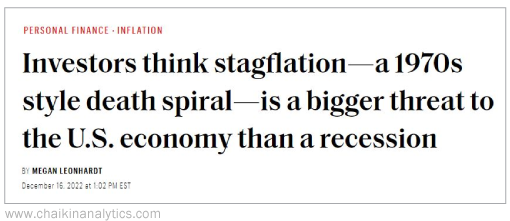The mainstream media is at it again…
News outlets are back to trumpeting “stagflation” fears. They’re certain it’s on the way.
In case you’re unfamiliar, stagflation is a period of high inflation and high unemployment at the same time.
I discussed the media’s infatuation with the term back in July. And five months later, not much has changed.
Here’s just one of many recent examples. Fortune magazine published this headline last week…

On the surface, it’s a reasonable fear.
After all, as I’ve said for most of this year, the Federal Reserve is going to put us in a recession. And if that happens, unemployment will go up and job openings will go down.
But the thing is, it would take a pretty major recession to relive the 1970s stagflation era.
In order for that to happen, the same number of folks would need to lose their jobs as during the COVID-19 shutdowns a couple years ago. And then, on top of that, two-thirds of these folks would need to be unable to find another job.
If that sounds crazy to you… that’s because it is.
Let’s take a closer look…
Measuring unemployment seems simple. It’s just the number of unemployed workers divided by the labor force.
However, in reality, it’s a bit more complicated…
You see, the labor force isn’t what most folks think it is. The labor force only consists of people who are employed or have actively looked for work in the previous four weeks.
So if you don’t have a job and you haven’t looked for one over the past month, you’re technically not unemployed. Instead, you’re what’s called a “discouraged worker.”
In order for the unemployment rate to rise, one of two things needs to happen…
- The number of actual unemployed workers needs to go up, or
- The total labor force (minus discouraged workers) needs to go down.
Let’s apply this idea to the stagflation era of the 1970s and early 1980s…
Back then, the unemployment rate peaked at nearly 11%. For context, during the 2008 and 2009 financial crisis, it peaked at about 10%. And during the COVID-19 shutdowns in 2020, it peaked at almost 15%.
Here’s the thing…
The unemployment rate is currently at 3.7%. That’s a long way from those previous peaks.
The ratio of job openings per unemployed person is just as important. In short, it tells us how likely people are to find new jobs if they lose their current ones.
The U.S. entered the COVID-19 era with 1.2 job openings per unemployed person. Today, this ratio is at 1.9.
In order for the country to hit 1.2 again, 18% of people would need to lose their jobs and the job openings would need to disappear. (And I don’t mean “disappear” as in get filled. I mean “disappear” as in the companies would stop hiring.)
That’s obviously a huge change. But we’re far away from those levels today. And trying to unpack the math makes the issue even more obvious…
Let’s say 10% of Americans lose their jobs during the next recession. And let’s say 20% of the available jobs disappear as well.
That would be a big shock to the system. And it would leave us at around 1.2 job openings per unemployed person. At that point, the unemployment rate would be roughly 13%.
But here’s why that’s unlikely…
This hypothetical scenario assumes that no one who becomes unemployed would find a new job.
And yet, with 1.9 current job openings per unemployed person, at least one-third of unemployed people should be able to do that. If that happened, the unemployment rate would be 10%. If half the people found jobs, the unemployment rate would be 8.5%.
Regardless of what the unemployment rate could be, in order for 10% of the labor force to be unemployed… roughly 16 million people would need to lose their jobs.
During the worst few months of the COVID-19 shutdowns in mid-2020, 16.6 million people lost their jobs. So it’s possible.
But even if the Fed throws us into a recession, I just don’t think the recession will be as bad as the world shutting down.
In other words, I doubt 16 million people will lose their jobs.
So where does that leave us on stagflation?
Folks, things look bleak in the real world. And they’re getting worse. A recession is likely coming.
But the reality is that we’re still a long way from the stagflation levels of the 1970s.
In fact, for us to get there, another COVID-19-level shutdown would need to occur. And while I’ll never say never, that kind of outcome seems unlikely today.
Good investing,
Karina Kovalcik